 ACT Expo 2016 reflected a few changes emerging in the clean transportation space – adoption of more electrified vehicles by fleets and freight movers; results of a study detailing the benefits of using renewable natural gas; speaker panels delving into the future of urban mobility and autonomous vehicles; and a revised name for the sixth annual conference and expo.
ACT Expo 2016 reflected a few changes emerging in the clean transportation space – adoption of more electrified vehicles by fleets and freight movers; results of a study detailing the benefits of using renewable natural gas; speaker panels delving into the future of urban mobility and autonomous vehicles; and a revised name for the sixth annual conference and expo.
Advanced Clean Transportation (ACT) Expo, formerly known as Alternative Clean Transportation Expo, was held May 2-5 in Long Beach, Calif. The sixth annual event was well attended and its expo hall was filled with displays from vehicle manufacturers and alternative fuel conversion companies, fueling infrastructure suppliers; electric vehicle charging suppliers; and tables staffed by government agencies and NPOs serving the community. The event was co-hosted with the Electric Drive Transportation Association (EDTA), the Propane Education & Research Council (PERC), NGVAmerica, the North American Council for Freight Efficiency (NACFE), and the California Hydrogen Business Council (CHBC). Penske Truck Leasing was the 2016 presenting sponsor.
Conversations were filled with discussions of two hot topics coinciding with the event: the California Sustainable Freight Action Plan being released Tuesday in draft form with a two-month comment period. The plan calls for the launch of more than 100,000 zero- and near-zero emissions trucks and other freight-moving equipment throughout the state by 2030. A day later, the state awarded $23.6 million to the South Coast Air Quality Management District (SCAQMD) for a zero-emission drayage truck development and demonstration project. It will bring 43 battery electric and plug-in hybrid drayage trucks to major California ports. The South Coast air district is teaming up with air districts in the Bay Area, Sacramento, San Diego and San Joaquin Valley to roll out demonstration trucks and charging infrastructure for emission reduction benefits in key areas of California with drayage truck activity. California Air Resources Board Vice Chair Sandy Berg and L.A. City Councilman and SCAQMD Board Member Joe Buscaino led a presentation of the award Wednesday afternoon in the ACT Expo hall.
On Tuesday morning, event organizer Gladstein Neandross & Associates (GNA) released “Game Changer,” a technical white paper – written on behalf of multiple private and public sector organizations – that explores the need and approaches to start deploying zero-emission and near-zero-emission heavy-duty vehicle technologies on a wide-scale basis in the U.S. The white paper has compared four fuel-technology combinations to address these goals and has concluded that there is only one pathway that meets the commercial feasibility and logistics tests to immediately begin this transformation. This is near-zero-emission heavy-duty natural gas vehicles fueled by increasing volumes of ultra-low-GHG renewable natural gas (RNG). This topic was also part of a speaker panel that morning at ACT Expo featuring SoCalGas president and CEO Dennis Arriola. Read more about the white paper.
On Thursday morning, Genevieve Cullen, president of Electric Drive Transportation Association (EDTA), kicked off “Charging Ahead with EVs.” Hybrid electric vehicles, battery electric vehicles (BEVs), plug-in hybrid electric vehicles (PHEVs), and fuel cell vehicles are gaining interest and acquisitions from light-duty fleets; PHEVs and BEVs are starting to see penetration in medium-duty fleets; BEVs are taking off with transit bus fleets; and extended range and hybrid configurations are gaining interest in the market as more technologies roll out, Cullen said. Technology drivers include 50% fuel efficiency gains from hybrid systems, up to 80% with PHEVs, reduced fuel costs and overall operating costs, and measureable emissions reductions, she said.
Jedediah Greenfield, public information and sustainability officer for the City of Houston, chaired a panel on automakers and electric vehicles being used in fleets. Jamie Hall, manager of public policy at General Motors, said that the upcoming Chevrolet Bolt is gaining interest from fleets and consumers for its 200-plus charging range and the various applications it offers as a crossover utility vehicle. Hall said that battery degradation continues to be an area of concern for EV acquisitions; and that none of the Chevrolet Volt batteries have needed to be replaced. Robert Langford, manager, plug-in electric vehicle sales for American Honda Motor Co., thinks that public charging is a driver of EV adoption that needs more support. Smart locations, available charging, and continued growth in DC fast chargers are needed, he said. Langford also talked about two plug-in versions of the Honda Clarity rolling out, joining the Clarity Fuel Cell. Marc Deutsch, EV business development manager for Nissan North America, said that Nissan is selling a lot of certified pre-owned and used Leafs. Pre-owned Leafs are bringing opportunities to disadvantaged communities. Challenges continue for bringing Leafs and other EVs to multiple-dwelling units along with the needed chargers, Deutsch said.
Keynote speaker Andrea Pratt, green fleet and fuel program manager at City of Seattle, explained the total cost of ownership (TCO) model the city has been using in vehicle acquisitions and reporting. Switching over from internal combustion engine vehicles to battery electric vehicles such as the Nissan Leaf has brought big savings to the city – over $2.2 million in operating cost savings by bringing in 150 EVs, she said. It’s been part of the Drive Clean Seattle program transitioning away from fossil fuels in transit and the city fleet, Pratt said.
Emily Castor, director of transportation policy at Lyft, spoke on the “Autonomous and Connected Urban Mobility: Tackling Challenges & Opportunities” panel. Castor talked about how its ridesharing now makes up 40% of the rides in 15 U.S. cities testing out the Lyft Lanes ridesharing service. Castor also talked about a short-term lease program Lyft is trying out with General Motors offering Lyft drivers an opportunity to rent a Chevrolet Volt for rides. Sustainability has been built into Lyft’s strategy of providing mobility services in cities, Castor said.
Workhorse Group received a good deal of attention during the week. Steve Burns, CEO of the company gave a presentation on Workhorse Group’s medium-duty, battery-electric trucks and fully integrated unmanned aerial delivery drones. At its booth, the company showed a video at its display featuring a small drone launching from the top of a delivery truck, flying a package to a nearby house and returning to the vehicle. There was also a display vehicle in the hall featuring a UPS electric vehicle provided by Workhorse Group. Last year, UPS announced the deployment of 18 electric, zero emission delivery vehicles to the Houston-Galveston area in Texas; and 125 hybrid electric delivery trucks rolling into the fleet in Arizona, Texas, Nevada, Mississippi, Alabama, Georgia, and Florida during the first half of 2016. These electric and hybrid delivery vehicles are being produced by Workhorse Group in collaboration with UPS.
During a keynote address, Carlton Rose, president of global fleet maintenance and engineering for UPS, discussed the company’s 6,800 clean vehicles running on CNG, LNG, propane, electric and hydraulic hybrid combinations, and all-electric. Rose called on his colleagues in the audience, especially truck operators and government agencies, to collaborate on investing in the clean technology and fuel, and adopting forward-thinking polices and incentives.
Highlights from the ACT Expo show floor included:
- Los Angeles Police Department electric display vehicles showcasing BMW i3 and Tesla Model S patrol cars, which were introduced last fall.
- BYD’s electric bus being used by Long Beach Transit, and medium-duty electric trucks for delivery fleets. BYD was one of the vehicle manufacturers acknowledged for the SCAQMD zero emission truck grant, along with Kenworth, Peterbilt, and Volvo.
- Love’s Travel Stops and Trillium CNG unveiled the companies’ new consolidated logo showing a visual representation of how the two companies will continue to serve the market. Love’s recently acquired Trillium CNG, a veteran compressed natural gas company. This will expand the company’s reach across the country and offerings to customers, the company said.
- ChargePoint unveiled the new CPF25 charging station and upgrades to its Fleet Plan. That announcement coincided with the company raising $50 million from private investors to expand its offerings.
- ClipperCreek unveiled the HCS Series with ChargeGuard, an affordable access control solution designed for fleet, workplace, multi-tenant, hospitality, and residential charging applications.
- The California Truck Equipment Company (CTEC), of Downey, Calif., and Rockport Commercial Vehicles, out of Elkhart, Ind., are two of the latest vehicle builders to offer all-electric versions of their existing commercial vehicles using the Motiv All-Electric Powertrain. Motiv said that it will make the Rockport all-electric box truck available for test drives through demonstrations and short-term leases to support fleets in making the decision to add electric vehicles.
- Spire Natural Gas Fueling Solutions and Mainstay Fuel Technologies, Inc. announced a partnership that will link Spire’s CNG fueling station offerings with Mainstay’s CNG vehicle fuel system expertise to provide “customized” CNG vehicle and fueling station solutions tailored to specific fleet needs; along with competitive pricing both on the road and at the pump, said Peter Stansky, senior vice president and COO of Spire.
- While the company announced it after ACT Expo, J-W Power Company announced that it has developed a new patent-pending compressed natural gas (CNG) technology, J-W PowerFill Compressor, that significantly improves the customer’s fueling experience with decreased fill time at the dispenser. “If you are planning to build a CNG fueling station, J-W PowerFill Technology increases flow rates without increasing horsepower, significantly increases use of onsite storage, reduces starts and stops on equipment, and ultimately enhances the customer’s fueling experience,” said James Barr, Vice President J-W Power Company.
The ACT Expo Fleet Awards launched this year to recognize fleet operators showing true leadership in sustainable transportation. Winners were:
Shipper Award: Unilever
Awardee: Fabio Baldassari, Logistics Strategic Sourcing Manager – Americas
Unilever’s commitment to sustainability throughout their supply chain has grown into CNG for transporting their products to market.
The first pilot project with GAIN Clean Fuel took place in Edwardsville, IL, where carriers for Unilever consume over 1 Million gallons of CNG/year moving goods to market.
The company has additionally reduced energy consumption in its factories by 20%.
Carrier Award: Central Freight Lines
Awardee: Donald Orr, President
Central Freight Lines has been a leader in promoting the use of CNG in the State of Texas.
Became one of the first LTL carriers to purchase CNG tractors in 2012.
Don Orr has been a visionary who realized the impact of CNG usage in heavy duty trucks and has “walked the talk” with his clean air initiatives.
Shipper/Carrier Partnership Award: Lowe’s & NFI
Awardees: Kevin McDonough, Regional Transportation Director, Lowe’s and Bill Bliem, Vice
President, Maintenance, NFI
Lowe’s dedicated fleet at Mount Vernon is among the first serving a major retail distribution center in North America to run solely on natural gas.
Currently working with carriers to transition all regional distribution center dedicated fleets to natural gas by end of 2017.
The company began using natural gas trucks last year at its distribution center in Kissimmee, Fla., and teamed with longtime carrier partner NFI to launch the natural gas dedicated fleet in Texas.
Private Fleet Award: Ruan Transportation
Awardee: Steve Larsen, Director of Procurement and Fuel
Ruan Transportation Management Systems maintains a fleet of approximately 100 compressed natural gas (CNG) tractors.
Currently, nearly 50% of their CNG fleet, 42 trucks in total, provides service for the Indiana dairy, Fair Oaks Farms.
This is a particularly unique case as the trucks are fueled by renewable CNG produced at the dairy. The methane is created from animal waste in an onsite anaerobic digester and piped to a station where it is compressed for fueling by the fleet.
Public Fleet Award: City of Seattle
Awardee: Andrea Pratt, Green Fleet & Fuel Program Manager
Andrea is an enthusiastic champion for cleaner fuels and has helped position the City of Seattle as one of the most progressive fleets in the region.
Seattle was one of the first cities to purchase EVs for a fleet application back in 2011.
The City’s motor pool has nearly 80 plug-in electric/electric-hybrid vehicles – the majority of which are dedicated battery electric. She also established a contract with a local biodiesel provider for more favorable rates than what was offered on the state contract.
Seattle is now planning one of the largest EV infrastructure projects ever seen in the US, with over 400 charging stations.
Transit & Mobility Award: SuperShuttle
Awardee: Karen Fish, Director of Franchising (award will be accepted by Bird Dave, President)
SuperShuttle has been an early adopter of various alternative fueled vehicles, including a significant amount of CNG and LPG, in various markets.
Has been deploying AFVs since 2009.
Purchased 130 CNG vans in 2014.
Has 160 propane vans nationwide as of 2014.
The San Francisco operation is 100% CNG.
Utility Award: PG&E
Awardee: Dave Meisel, Senior Director – Transportation & Aviation Services (award was accepted by Brian Pepper, Senior Program Manager)
PG&E operates one of the cleanest fleets in the utility industry.
Fleet includes hybrid electric utility trucks, electric bucket trucks, extended-range pickups, and battery electric and plug-in hybrid sedans.
The Class 5 utility truck features exportable power capable of supplying 120 kW, which allows the vehicle to be plugged directly into the grid and power up to 100 homes during outages.
Bucket trucks have a plug-in battery-powered system called JEMS that operates the auxiliary systems, including the bucket, lights, hydraulic lifts, heating and air conditioning, and tools.
Work Truck Award: AmeriPride Services
Awardee: Banny Allison, Fleet Services Manager
Banny Alison has lead AmeriPride in their fleet’s commitment to the environment and the communities where they work.
As one of the biggest operators in the textile delivery industry, they are setting the standard for clean operations and continue to make improvements to delivery operations and invest resources to test and help advance new green technologies.
They have invested in a variety of alternatively fueled walk-in vans, including those that operate on electricity, propane, compressed natural gas and hybrid drivetrains.
The company also invests in efficiency technologies including trailer skirting and doubledecker semi-trailers, fuel efficient sedans for the service team, and the installation of telematics technology and route optimization software to reduce mileage and increase efficiency.
“In it For the Long Haul” Award: UPS
Awardee: Mike Britt, Director of Maintenance & Engineering International Operations Ground
Fleet (award was accepted by Carlton Rose, President, Global Fleet Maintenance & Engineering)
UPS has always been an early adopter of innovative technologies. In the early 1930s, they introduced electric vehicles into our fleet.
Today, they operate one of the industry’s largest private alternative fuel and advanced technology fleets made up of more than 5,000 low-emissions vehicles.
UPS tests and deploys a variety of vehicle types, matched to the terrain and delivery conditions at each location. This approach helps UPS continuously integrate new technologies and operational efficiencies in its large, global delivery fleet.
UPS has demonstrated their commitment to the NGV market through their continued acquisition of both heavy and medium duty CNG vehicles.
They have additionally deployed electric and ethanol vehicles in vehicles that complete short city trips, propane vehicles in rural areas, and LNG in long-haul applications.
Since 2000, their alternative fuel and advanced technology vehicles have logged more than 500 million miles in the U.S., Germany, Canada, Netherlands, Chile, Thailand, Hong Kong, South Korea, Brazil and the United Kingdom.
NGVAmerica President Matthew Godlewski honored two recipients with the 2016 NGV Achievement Awards, FCA US LLC and Anheuser-Busch, during the Fleet Awards dinner. FCA, the first to market a factory-built pickup truck powered by compressed natural gas (CNG), the bi-fuel Ram 2500, recently committed approximately $40 million to FCA Transport, an FCA US-owned truck fleet, to convert 179 diesel-fueled parts-haulers to run on clean-burning natural gas at its Detroit Terminal. Annually, this new fleet will displace nearly 3.3 million gallons of diesel fuel and dramatically reduce CO2 emissions. Through its “Seed-To-Sip” sustainability initiative, Anheuser-Busch is committed to reducing the energy and emissions in both the brewing and transportation of their beers. In 2015, its flagship brewery in St. Louis replaced all 97 diesel-fueled tractors with new CNG-powered trucks, following the deployment of 66 CNG trucks in Houston the prior year.
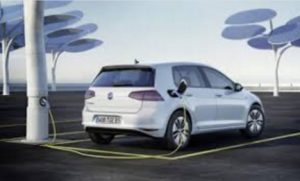 VW EV 2025 target: As Volkswagen Group emerges from its diesel emissions scandal and faces increasingly strict government mandates on reducing vehicle carbon emissions, the German automaker expects electric vehicle sales to increase substantially by 2025. VW says it will have to sell about one million battery electric and plug-in hybrid vehicle per year by that year. VW projected that volume by analyzing regulatory environments in key markets, including draft legislation in China. That will require a huge leap from where VW stands right now in EV sales. Total cumulative volumes of all VW brand electrified cars (including VW, Audi, and Porsche) sold since the start is expected to be about 103,000 by the end of this year. For the first four months of 2016, the company sold just shy of 3,000 EV units in the U.S. with the Audi A3 Plug In, VW e-Golf, and Porsche Cayenne S E-Hybrid, according to HybridCar’s Dashboard.
VW EV 2025 target: As Volkswagen Group emerges from its diesel emissions scandal and faces increasingly strict government mandates on reducing vehicle carbon emissions, the German automaker expects electric vehicle sales to increase substantially by 2025. VW says it will have to sell about one million battery electric and plug-in hybrid vehicle per year by that year. VW projected that volume by analyzing regulatory environments in key markets, including draft legislation in China. That will require a huge leap from where VW stands right now in EV sales. Total cumulative volumes of all VW brand electrified cars (including VW, Audi, and Porsche) sold since the start is expected to be about 103,000 by the end of this year. For the first four months of 2016, the company sold just shy of 3,000 EV units in the U.S. with the Audi A3 Plug In, VW e-Golf, and Porsche Cayenne S E-Hybrid, according to HybridCar’s Dashboard.

 Have you ever taken an Uber ride to the airport, work, concert, or out on a date? Not only have I taken a few Uber rides, I’ve put in quite a few hours and miles on the road as an Uber driver. I’ve also written a non-fiction book about it that was published Friday on Kindle,
Have you ever taken an Uber ride to the airport, work, concert, or out on a date? Not only have I taken a few Uber rides, I’ve put in quite a few hours and miles on the road as an Uber driver. I’ve also written a non-fiction book about it that was published Friday on Kindle, 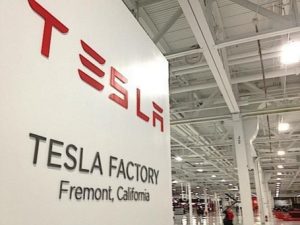 Tesla taking heat over immigrant worker and supplier relations: Tesla Motors has been facing challenges lately on the vehicle manufacturing front; one of these controversies comes from
Tesla taking heat over immigrant worker and supplier relations: Tesla Motors has been facing challenges lately on the vehicle manufacturing front; one of these controversies comes from 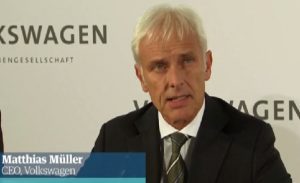 Volkswagen CEO Matthias Mueller will be speaking to the company’s senior management in mid-June on how VW will emerge from the diesel emissions scandal more as a
Volkswagen CEO Matthias Mueller will be speaking to the company’s senior management in mid-June on how VW will emerge from the diesel emissions scandal more as a 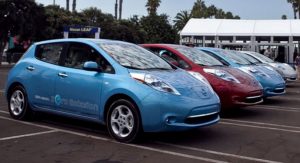 Colorado EV incentive: Colorado, which has long been an electric vehicle friendly state, is switching over from a formula-based tax credit to
Colorado EV incentive: Colorado, which has long been an electric vehicle friendly state, is switching over from a formula-based tax credit to  It’s been a big year for breaking news on the clean mobility front, with General Motors investing a half billion in Lyft and Apple announcing last week that it’s investing $1 billion in Didi Chuxing Technology. Apple appears to be just as serious about investing in mobility services as is Silicon Valley neighbor Google and its self-driving car project.
It’s been a big year for breaking news on the clean mobility front, with General Motors investing a half billion in Lyft and Apple announcing last week that it’s investing $1 billion in Didi Chuxing Technology. Apple appears to be just as serious about investing in mobility services as is Silicon Valley neighbor Google and its self-driving car project.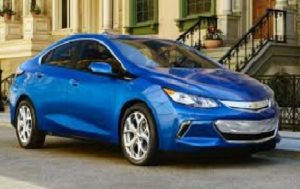 EV sales in April: Plug-in hybrids are taking the lead this year, jumping 40 percent in first quarter U.S. sales versus that same period in 2015, according to Edmunds.com. In April, they were up 96.4% over April 2015 and up 9.6% over March 2016. Battery electric vehicles were down nearly 12% from the previous month and were up 3.8% over the previous year according to
EV sales in April: Plug-in hybrids are taking the lead this year, jumping 40 percent in first quarter U.S. sales versus that same period in 2015, according to Edmunds.com. In April, they were up 96.4% over April 2015 and up 9.6% over March 2016. Battery electric vehicles were down nearly 12% from the previous month and were up 3.8% over the previous year according to  ACT Expo 2016 reflected a few changes emerging in the clean transportation space – adoption of more electrified vehicles by fleets and freight movers; results of a study detailing the benefits of using renewable natural gas; speaker panels delving into the future of urban mobility and autonomous vehicles; and a revised name for the sixth annual conference and expo.
ACT Expo 2016 reflected a few changes emerging in the clean transportation space – adoption of more electrified vehicles by fleets and freight movers; results of a study detailing the benefits of using renewable natural gas; speaker panels delving into the future of urban mobility and autonomous vehicles; and a revised name for the sixth annual conference and expo.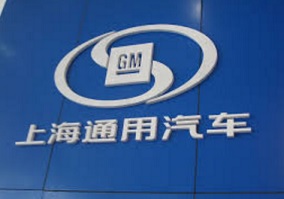 GM China Launching EVs: General Motors, along with China-based partner SAIC, plans to launch more than 10 new electrified vehicles in China by 2020,
GM China Launching EVs: General Motors, along with China-based partner SAIC, plans to launch more than 10 new electrified vehicles in China by 2020, 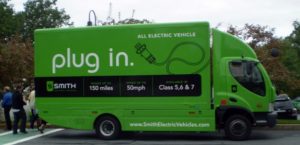 Fleets, freight and logistics companies, and urban transportation planners are looking at best practices for hitting targets in greenhouse gas emissions, air pollution, fuel consumption, and mobility in crowded cities. That will be a discussion topic this week at
Fleets, freight and logistics companies, and urban transportation planners are looking at best practices for hitting targets in greenhouse gas emissions, air pollution, fuel consumption, and mobility in crowded cities. That will be a discussion topic this week at